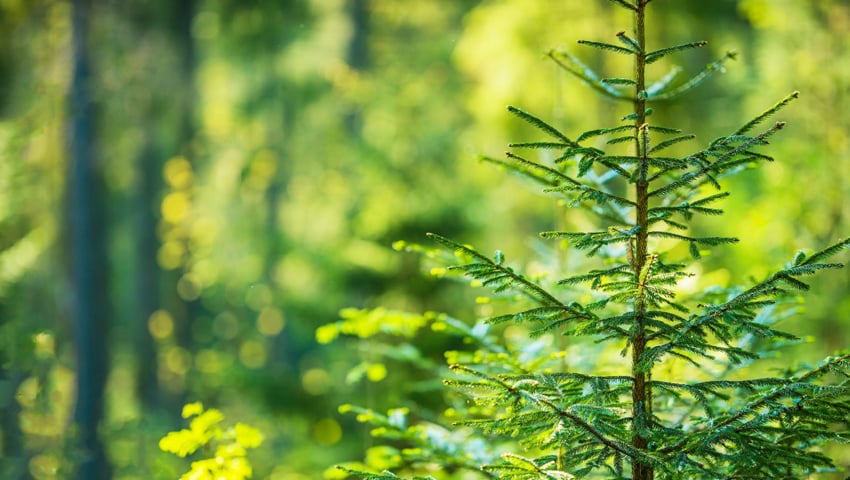COMMERCIAL forestry values fell for the first time in almost a decade with a 10%-20% drop in the past year, according to a new industry report launched in London.
The UK Forest Market Report 2023 is the most comprehensive publicly available year-on-year record of agreed deals in the UK forestry sector. It has been produced by Tilhill – the UK’s leading forestry services company – and specialist forestry agency Goldcrest Land & Forestry Group. (The period covered by the report is the 1st September 2022 to 31st August 2023. )
The report said, “Compared to the rampaging run of forestry as an asset class over the last 17 years, the lagging effect of economic turmoil from the mini budget, the war in Ukraine, and rising interest rates have softened market activity across the board in both afforestation and commercial/amenity woodlands.”
While highlighting the enduring resilience of UK forestry, the continuing emergence of new investors and confidence in the long-term future of timber underpinned by the need to replace plastic, steel and concrete with sustainable forest products, the report found that supply tightened, prices dropped and buyers became increasingly selective in the last year. Additionally, demand for timber slowed sharply in the short-term leading to a dramatic reduction in processing volumes.
2023 saw £212m of commercial forestry listings on the open market, up 9%, with two properties accounting for an “extraordinary” 70% of the total value listed for sale and Scotland enjoying a 91% market share. However, the number of listings fell 39% to just 35 properties.
Xander Mahony, head of forestry investment at Tilhill, said, “This continues the £200m observed market size trend into a fourth year. The headline number however, is boosted by two huge assets (Griffin in Perthshire and Glen Shira in Argyll) and flatters a market that was otherwise unusually small.”
Jon Lambert, partner at Goldcrest, said that most properties brought to the market had still sold but that after a “staggering” run, pricing was down 10-20% depending on quality and location. “Purchasers are generally more cautious than 12 or 18 months ago, leading to longer due diligence periods, an increased demand to rectify ‘blemishes’ before completion and a desire for higher yields.”
He highlighted a continuing demand for good quality planting land but said appropriate sites were hard to find. The total value of planting land listings amounted to £49.9m, down 24%.
In Scotland, average prices for planting land suitable for commercial forestry dropped 22% from £12,800 per gross hectare to £9,900 per gross hectare “in the most significant development across all forest market data this year”. England and Wales fared better, increasing 42% to £16,600 per gross hectare and £13,400 per gross hectare respectively.
It was hoped, according to the report, that a “normalisation in commercial planting land prices in Scotland would spur much needed woodland creation, both commercial and native” going forward.
Just 13,000 hectares of trees were planted this year, a drop of 7% and 43% of the national target of 30,000 hectares. While Scotland continued to lead the charge with 8,200 hectares planted – more than two thirds of which were conifers – this was a 27% drop from 10,400ha in 2022. Broadleaf planting amounted to 51% of all UK tree planting.
The report found that land listed for sale which could offer natural capital potential reached a massive £276m, up 241%, dwarfing the land suitable for commercial forestry. England had the biggest market by value with £144.5m while Scotland had the most land available with 13,394 hectares. Prices were highest in Wales at £17,000 per hectare.
Mixed woodland listings were down 18% at £15.8m with a 14% fall in average price to £12,500 per hectare. England, while marked by a 45% fall in total value and a 48% drop in total area, saw a rise in the number of listings (16) and a modest 5% rise in average value to £17,300 per hectare. In Wales, listings rose from 3 to 10. Average woodland values remained almost static in Scotland and Wales at £9,500 per hectare and £9,600 per hectare respectively.
Launched at the London WWT Wetlands Centre -at an event chaired by Mark Prentice, head of private banking at Hampden & Co, the report called for the sector to work together to change public attitude to Sitka spruce.
“It is, after all, the industry’s commercial crop and the workhorse of our timber industry,” the report said. “Given the urgent need to grow more UK timber – and meet climate mitigation obligations – we must address how the timber industry can make Sitka spruce more palatable.”
